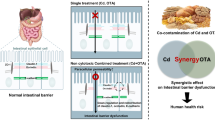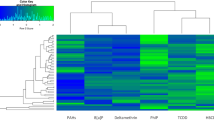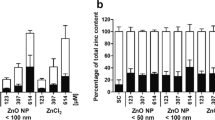Abstract
Dietary exposure to the organophosphorothionate pesticide chlorpyrifos (CPF) has been linked to dysbiosis of the gut microbiota. We therefore sought to investigate whether (i) CPF’s impact extends to the intestinal barrier and (ii) the prebiotic inulin could prevent such an effect. In vitro models mimicking the intestinal environment (the SHIME®) and the intestinal mucosa (Caco-2/TC7 cells) were exposed to CPF. After the SHIME® had been exposed to CPF and/or inulin, we assessed the system’s bacterial and metabolic profiles. Extracts from the SHIME®’s colon reactors were then transferred to Caco-2/TC7 cultures, and epithelial barrier integrity and function were assessed. We found that inulin co-treatment partially reversed CPF-induced dysbiosis and increased short-chain fatty acid production in the SHIME®. Furthermore, co-treatment impacted tight junction gene expression and inhibited pro-inflammatory signaling in the Caco-2/TC7 intestinal cell line. Whereas, an isolated in vitro assessment of CPF and inulin effects provides useful information on the mechanism of dysbiosis, combining two in vitro models increases the in vivo relevance.




Similar content being viewed by others
Explore related subjects
Discover the latest articles and news from researchers in related subjects, suggested using machine learning.Abbreviations
- CPF:
-
chlorpyriphos
- SHIME®:
-
Simulator of the Human Intestinal Microbial Ecosystem
- cDNA:
-
complementary DNA
- D:
-
day
- TLR:
-
Toll-like receptor
- TEER:
-
transepithelial electrical resistance
References
Allsopp P, Possemiers S, Campbell D, Oyarzábal IS, Gill C, Rowland I (2013) An exploratory study into the putative prebiotic activity of fructans isolated from Agave angustifolia and the associated anticancer activity. Anaerobe 22:38–44. https://doi.org/10.1016/j.anaerobe.2013.05.006
Al-Moundhri MS, Al-Khanbashi M, Al-Kindi M et al (2010) Association of E-cadherin (CDH1) gene polymorphisms and gastric cancer risk. World J Gastroenterol 16:3432–3436
Antonopoulos DA, Huse SM, Morrison HG, Schmidt TM, Sogin ML, Young VB (2009) Reproducible community dynamics of the gastrointestinal microbiota following antibiotic perturbation. Infect Immun 77:2367–2375. https://doi.org/10.1128/IAI.01520-08
Candela M, Perna F, Carnevali P, Vitali B, Ciati R, Gionchetti P, Rizzello F, Campieri M, Brigidi P (2008) Interaction of probiotic Lactobacillus and Bifidobacterium strains with human intestinal epithelial cells: adhesion properties, competition against enteropathogens and modulation of IL-8 production. Int J Food Microbiol 125:286–292. https://doi.org/10.1016/j.ijfoodmicro.2008.04.012
Chaikham P, Apichartsrangkoon A (2014) Effects of encapsulated Lactobacillus acidophilus along with pasteurized longan juice on the colon microbiota residing in a dynamic simulator of the human intestinal microbial ecosystem. Appl Microbiol Biotechnol 98:485–495. https://doi.org/10.1007/s00253-013-4763-7
Chen X, Ouyang Q (2010) Study on the molecular expression and regulation of toll pathway in HT-29 cells. Sichuan Da Xue Xue Bao Yi Xue Ban 41:581–585
Cho KM, Math RK, Islam SMA, Lim WJ, Hong SY, Kim JM, Yun MG, Cho JJ, Yun HD (2009) Biodegradation of chlorpyrifos by lactic acid bacteria during kimchi fermentation. J Agric Food Chem 57:1882–1889. https://doi.org/10.1021/jf803649z
De Boever P, Deplancke B, Verstraete W (2000) Fermentation by gut microbiota cultured in a simulator of the human intestinal microbial ecosystem is improved by supplementing a soygerm powder. J Nutr 130:2599–2606
Fuentes MS, Briceño GE, Saez JM, et al (2013) Enhanced removal of a pesticides mixture by single cultures and consortia of free and immobilized Streptomyces strains. In: BioMed Res Int. https://www.hindawi.com/journals/bmri/2013/392573/abs/. Accessed 21 Feb 2018
Gao L, Nieters A, Brenner H (2008) Meta-analysis: tumour invasion-related genetic polymorphisms and gastric cancer susceptibility. Aliment Pharmacol Ther 28:565–573. https://doi.org/10.1111/j.1365-2036.2008.03760.x
González-Mariscal L, Domínguez-Calderón A, Raya-Sandino A, Ortega-Olvera JM, Vargas-Sierra O, Martínez-Revollar G (2014) Tight junctions and the regulation of gene expression. Semin Cell Dev Biol 36:213–223. https://doi.org/10.1016/j.semcdb.2014.08.009
Harishankar MK, Sasikala C, Ramya M (2013) Efficiency of the intestinal bacteria in the degradation of the toxic pesticide, chlorpyrifos. 3 Biotech 3:137–142. https://doi.org/10.1007/s13205-012-0078-0
Joly Condette C, Bach V, Mayeur C et al (2015) Chlorpyrifos exposure during perinatal period affects intestinal microbiota associated with delay of maturation of digestive tract in rats. J Pediatr Gastroenterol Nutr 61:30–40. https://doi.org/10.1097/MPG.0000000000000734
Joly C, Gay-Quéheillard J, Léké A, Chardon K, Delanaud S, Bach V, Khorsi-Cauet H (2013) Impact of chronic exposure to low doses of chlorpyrifos on the intestinal microbiota in the Simulator of the Human Intestinal Microbial Ecosystem (SHIME®) and in the rat. Environ Sci Pollut Res 20:2726–2734. https://doi.org/10.1007/s11356-012-1283-4
Kwok LY, Zhang J, Guo Z, Gesudu Q, Zheng Y, Qiao J, Huo D, Zhang H (2014) Characterization of fecal microbiota across seven Chinese ethnic groups by quantitative polymerase chain reaction. PLoS One 9:1–11. https://doi.org/10.1371/journal.pone.0093631
Lallès J-P (2014) Intestinal alkaline phosphatase: novel functions and protective effects. Nutr Rev 72:82–94. https://doi.org/10.1111/nure.12082
Lassiter TL, Ryde IT, Mackillop EA et al (2008) Exposure of neonatal rats to parathion elicits sex-selective reprogramming of metabolism and alters the response to a high-fat diet in adulthood. Environ Health Perspect 116:1456–1462. https://doi.org/10.1289/ehp.11673
Lecerf J-M, Dépeint F, Clerc E, Dugenet Y, Niamba CN, Rhazi L, Cayzeele A, Abdelnour G, Jaruga A, Younes H, Jacobs H, Lambrey G, Abdelnour AM, Pouillart PR (2012) Xylo-oligosaccharide (XOS) in combination with inulin modulates both the intestinal environment and immune status in healthy subjects, while XOS alone only shows prebiotic properties. Br J Nutr 108:1847–1858
Lu Y-C, Yeh W-C, Ohashi PS (2008) LPS/TLR4 signal transduction pathway. Cytokine 42:145–151. https://doi.org/10.1016/j.cyto.2008.01.006
Mainville I, Arcand Y, Farnworth ER (2005) A dynamic model that simulates the human upper gastrointestinal tract for the study of probiotics. Int J Food Microbiol 99:287–296. https://doi.org/10.1016/j.ijfoodmicro.2004.08.020
Mariat D, Firmesse O, Levenez F, Guimarăes VD, Sokol H, Doré J, Corthier G, Furet JP (2009) The Firmicutes/Bacteroidetes ratio of the human microbiota changes with age. BMC Microbiol 9:123. https://doi.org/10.1186/1471-2180-9-123
Marzorati M, den APV, Possemiers S et al (2011) Studying the host-microbiota interaction in the human gastrointestinal tract: basic concepts and in vitro approaches. Ann Microbiol 61:709–715. https://doi.org/10.1007/s13213-011-0242-5
Molly K, van de Woestyne M, Verstraete W (1993) Development of a 5-step multi-chamber reactor as a simulation of the human intestinal microbial ecosystem. Appl Microbiol Biotechnol 39:254–258. https://doi.org/10.1007/BF00228615
Muñoz-González C, Cueva C, Ángeles Pozo-Bayón M, Victoria Moreno-Arribas M (2015) Ability of human oral microbiota to produce wine odorant aglycones from odourless grape glycosidic aroma precursors. Food Chem 187:112–119. https://doi.org/10.1016/j.foodchem.2015.04.068
Park MS, Kim MJ, Ji GE (2007) Assessment of lipopolysaccharide-binding activity of Bifidobacterium and its relationship with cell surface hydrophobicity, autoaggregation, and inhibition of interleukin-8 production. J Microbiol Biotechnol 17:1120–1126
Rakoff-Nahoum S, Paglino J, Eslami-Varzaneh F, Edberg S, Medzhitov R (2004) Recognition of commensal microflora by toll-like receptors is required for intestinal homeostasis. Cell 118:229–241. https://doi.org/10.1016/j.cell.2004.07.002
Reygner J, Joly Condette C, Bruneau A, Delanaud S, Rhazi L, Depeint F, Abdennebi-Najar L, Bach V, Mayeur C, Khorsi-Cauet H (2016a) Changes in composition and function of human intestinal microbiota exposed to chlorpyrifos in oil as assessed by the SHIME(®) model. Int J Environ Res Public Health 13. https://doi.org/10.3390/ijerph13111088
Reygner J, Lichtenberger L, Elmhiri G, Dou S, Bahi-Jaber N, Rhazi L, Depeint F, Bach V, Khorsi-Cauet H, Abdennebi-Najar L (2016b) Inulin supplementation lowered the metabolic defects of prolonged exposure to chlorpyrifos from gestation to young adult stage in offspring rats. PLoS One 11:e0164614. https://doi.org/10.1371/journal.pone.0164614
Roberfroid M, Gibson GR, Hoyles L, McCartney AL, Rastall R, Rowland I, Wolvers D, Watzl B, Szajewska H, Stahl B, Guarner F, Respondek F, Whelan K, Coxam V, Davicco MJ, Léotoing L, Wittrant Y, Delzenne NM, Cani PD, Neyrinck AM, Meheust A (2010) Prebiotic effects: metabolic and health benefits. Br J Nutr 104(Suppl 2):S1–S63. https://doi.org/10.1017/S0007114510003363
Sambuy Y, De Angelis I, Ranaldi G et al (2005) The Caco-2 cell line as a model of the intestinal barrier: influence of cell and culture-related factors on Caco-2 cell functional characteristics. Cell Biol Toxicol 21:1–26. https://doi.org/10.1007/s10565-005-0085-6
Singh PB, Sharma S, Saini HS, Chadha BS (2009) Biosurfactant production by Pseudomonas sp. and its role in aqueous phase partitioning and biodegradation of chlorpyrifos. Lett Appl Microbiol 49:378–383. https://doi.org/10.1111/j.1472-765X.2009.02672.x
Sivieri K, Morales MLV, Saad SMI, Adorno MAT, Sakamoto IK, Rossi EA (2014) Prebiotic effect of fructooligosaccharide in the simulator of the human intestinal microbial ecosystem (SHIME® model). J Med Food 17:894–901. https://doi.org/10.1089/jmf.2013.0092
Sokol H, Pigneur B, Watterlot L, Lakhdari O, Bermudez-Humaran LG, Gratadoux JJ, Blugeon S, Bridonneau C, Furet JP, Corthier G, Grangette C, Vasquez N, Pochart P, Trugnan G, Thomas G, Blottiere HM, Dore J, Marteau P, Seksik P, Langella P (2008) Faecalibacterium prausnitzii is an anti-inflammatory commensal bacterium identified by gut microbiota analysis of Crohn disease patients. Proc Natl Acad Sci U S A 105:16731–16736. https://doi.org/10.1073/pnas.0804812105
Sousa T, Paterson R, Moore V, Carlsson A, Abrahamsson B, Basit AW (2008) The gastrointestinal microbiota as a site for the biotransformation of drugs. Int J Pharm 363:1–25. https://doi.org/10.1016/j.ijpharm.2008.07.009
Steffen EK, Berg RD (1983) Relationship between cecal population levels of indigenous bacteria and translocation to the mesenteric lymph nodes. Infect Immun 39:1252–1259
Terpend K, Possemiers S, Daguet D, Marzorati M (2013) Arabinogalactan and fructo-oligosaccharides have a different fermentation profile in the Simulator of the Human Intestinal Microbial Ecosystem (SHIME ®). Environ Microbiol Rep 5:595–603. https://doi.org/10.1111/1758-2229.12056
Tirelli V, Catone T, Turco L, di Consiglio E, Testai E, de Angelis I (2007) Effects of the pesticide clorpyrifos on an in vitro model of intestinal barrier. Toxicol in Vitro 21:308–313. https://doi.org/10.1016/j.tiv.2006.08.015
Topping DL, Clifton PM (2001) Short-chain fatty acids and human colonic function: roles of resistant starch and nonstarch polysaccharides. Physiol Rev 81:1031–1064
van de Wiele T, Boon N, Possemiers S et al (2004) Prebiotic effects of chicory inulin in the simulator of the human intestinal microbial ecosystem. FEMS Microbiol Ecol 51:143–153. https://doi.org/10.1016/j.femsec.2004.07.014
van de Wiele T, Boon N, Possemiers S, Jacobs H, Verstraete W (2007) Inulin-type fructans of longer degree of polymerization exert more pronounced in vitro prebiotic effects. J Appl Microbiol 102:452–460. https://doi.org/10.1111/j.1365-2672.2006.03084.x
Verhoeckx KCM, Vissers YM, Baumert JL, Faludi R, Feys M, Flanagan S, Herouet-Guicheney C, Holzhauser T, Shimojo R, van der Bolt N, Wichers H, Kimber I (2015) Food processing and allergenicity. Food Chem Toxicol Int J Publ Br Ind Biol Res Assoc 80:223–240. https://doi.org/10.1016/j.fct.2015.03.005
Vogt L, Meyer D, Pullens G, Faas M, Smelt M, Venema K, Ramasamy U, Schols HA, de Vos P (2015) Immunological properties of inulin-type fructans. Crit Rev Food Sci Nutr 55:414–436. https://doi.org/10.1080/10408398.2012.656772
von Martels JZH, Sadaghian Sadabad M, Bourgonje AR, Blokzijl T, Dijkstra G, Faber KN, Harmsen HJM (2017) The role of gut microbiota in health and disease: in vitro modeling of host-microbe interactions at the aerobe-anaerobe interphase of the human gut. Anaerobe 44:3–12. https://doi.org/10.1016/j.anaerobe.2017.01.001
Wang Z, Wang J, Cheng Y, Liu X, Huang Y (2011) Secreted factors from Bifidobacterium animalis subsp. lactis inhibit NF-κB-mediated interleukin-8 gene expression in Caco-2 cells. Appl Environ Microbiol 77:8171–8174. https://doi.org/10.1128/AEM.06145-11
Zhao L (2013) The gut microbiota and obesity: from correlation to causality. Nat Rev Microbiol 11:639–647. https://doi.org/10.1038/nrmicro3089
Acknowledgments
The authors thank David Fraser (Biotech Communication SARL, Ploudalmézeau, France) for copy editing assistance. The authors also wish to thank Cosucra for kindly providing the inulin used in this project.
Funding
This study is supported by the French Ministry of Research and Higher Education through MR’s postgraduate fellowship. They thank the Picardy Regional Council for providing funding.
Author information
Authors and Affiliations
Contributions
HKC, FD, and VB designed the research program; HKC and FD conceived and designed the SHIME® and cell-based experiments, respectively; DOGA, MR, and LR performed the experiments and assays; DOGA, MR, and VB analyzed the data; SD contributed materials and analytical tools for the SHIME®; MR, DOGA, FD, and HKC wrote, evaluated, and revised the manuscript. All authors read and approved the final manuscript.
Corresponding author
Ethics declarations
Conflict of interest
The authors declare that they have no conflicts of interest.
Additional information
Responsible editor: Philippe Garrigues
Electronic supplementary material
ESM 1
(DOCX 47 kb)
Rights and permissions
About this article
Cite this article
Réquilé, M., Gonzàlez Alvarez, D.O., Delanaud, S. et al. Use of a combination of in vitro models to investigate the impact of chlorpyrifos and inulin on the intestinal microbiota and the permeability of the intestinal mucosa. Environ Sci Pollut Res 25, 22529–22540 (2018). https://doi.org/10.1007/s11356-018-2332-4
Received:
Accepted:
Published:
Issue Date:
DOI: https://doi.org/10.1007/s11356-018-2332-4




